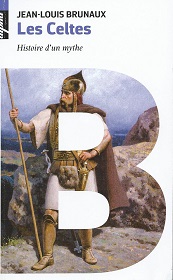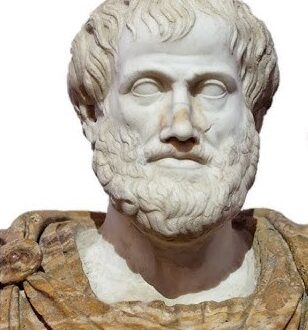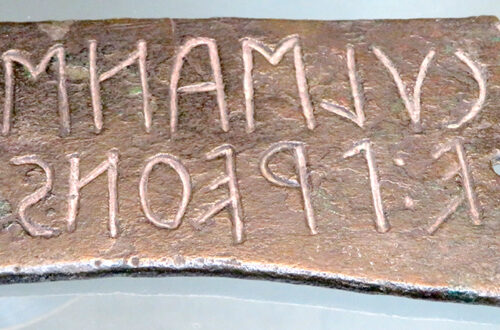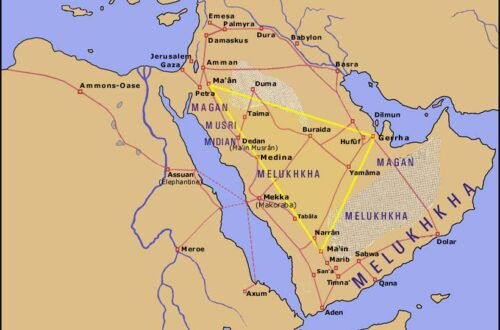
The Celtic Myth
Uwe Topper, Berlin · 2018
Conflict around the Celtic myth
Review of a book by Jean-Louis Brunaux: The Celts. Histoire d’un myth (Belin éditeur, Paris 2014)
The myth “Celts” is critically examined by an established archeologist and historian, Jean-Louis Brunaux (director at the CNRS) who sweeps the corresponding inventions and gives the dreamy romantics of Pan-Celtism the long-needed enlightenment: strictly speaking, Celts existed only as a tribal federation between the 6th and 1st century BC in central and southern France. This term was (mainly in the 19th century) extended to the “Celtic” islands and decorated with monuments of a nearly forgotten language, such as the songs of Ossian and the Breton bards, partially due to political reasons which began with the Huguenots (16th century) and proliferated in the French revolution of 1789. Today, Europe-wide Celts are part of our standard knowledge.
First of all, this book has been overdue for some time. After I had uncovered the Latin invention of the so called prehistoric “Germans” twenty years ago (1996, see note here) and the deceptive Slavic legend had been cleared by colleagues, Shlomo Sand came out with two books on the invention of the Jewish people and country ( go in 2011 and 2013). Now the Celts are being scrutinized by Brunaux. It turns out to be – again, it has to be stressed – not a political or ideological controversy but simply one of investigation: how did these terms (Teutons, Slavs, Celts, etc.) come about, who proposed them first, when and how were they developed, and finally: what is left, if one resorts to the basic definitions?
I read this book with fascination. It is written in clear language, addresses the problems without detours. From the repetitions, especially at the beginning of chapters, but also from the lively choice of words, one imagines that these are lectures, namely from the notes to seminars that Brunaux held at the ENS (École Normale Supérieure) from 2008 to 2011 (as said in note 1 to the introduction to the book).
The comprehensive term Celts, says the respected author, historian and archaeologist, Brunaux in the introduction (p. 10), did not appear until the Renaissance, when German humanists began to trace their ancestry back to the Celts, while in France only Gaul appeared as an ancestor, much like in Latin texts a thousand years before, whereas the Greeks four centuries before already spoke about Celts.
Brunaux quotes several times (see p. 10) the fantastic writer Tolkien, who has abundantly drawn from the Celtic reservoir and said in his inaugural speech at the University of Oxford: “‘Celtic’ of any sort is, nonetheless, a magic bag, into which anything may be put, and out of which almost anything may come.”
To create a catalog of the Celts, one would first have to know what the term means, but that is precisely what we can not do (p. 12, with a side-punch to the standard work of Wenceslas Kruta of 1988, Paris 2000).
We see, however, that Brunaux, with his precise knowledge of the literature, generously employs chronology. The concept of the Celts was already used for 30 centuries (page 12), he says. This is a bit to much if on the other hand he found a Greek to be the first who mentions Celts (but at the end, p. 345, he correctly says 26 centuries). Or this example: he refers to the employment of this term, that is, the search for ones ancestors, as having taken place six centuries ago (p. 13), which is too high for the German renaissance, five centuries would suffice.
Or this one: The black hole of descent had finally been closed when the Indo-Europeans were invented almost three centuries ago (p. 13) – well, two centuries would be sufficient, for the invention of the Indo-Europeans began in 1810 and 1813, solidified by Klaproth (1823) ) and Bopp (1833). Probably, Brunaux meant the concept itself in an expanded sense, not literally the term itself, as he elaborates in later chapters.
The introduction ends with the clear sentence (p. 16): “It is the history of this invention, renewed time and again, that we undertake here.”
Evolution
In Chapter II “The Aborigines of the West” (in the section “The oldest written mention”) he presents the basic evidence, the first mention of the Celts in Greek texts. While the author is aware of the problem that there may be some doubt (put forward by experts), he bases his entire argument on this mention of the word “Keltike.” It goes back to a fragment of about seven words, which must come from Hecataeus of Miletus: “Massalia, city of Ligustia, colony of the Phoceans, near the Keltike.” (P. 59) This can only refer to a region.
There happens to be also a Hecataeus of Abdera who wrote two hundred years later as his colleague of Miletus, but already in antiquity they were confused; probably the one from Abdera has to quit here. The Hekataios fragment is preserved only in a text thousand years younger and attributed to Stephan of Byzanz. Why Stephan has handed down those few antiquated words with completely unclear geography, although as a contemporary of Belisarius, who ruled almost the entire Mediterranean with his fleet, he knew Marseille quite well or knew how to label the Ligurians correctly, but where the ” Keltike” exactly lies, remains a mystery.
It turns out that the text of Stephan appears only in an excerpt from Hermolaos, which is preserved in the Suda collection about half a millennium later. The tradition has just here the usual gaps and big jumps. If one Greek copied the other as in this case could be, then no doubt they confirm each other. Actually, we know this Greek literature only through our diligent philologists of the 19th century (see, for example, Groskurd, Christoph Gottlieb 1831: Earth description of Strabo in 17 books; reprint Georg Olms Verlag, 590 pages) keyword Keltike.
After some Greek writers had communicated the name “Celts” for a northern population that was mostly indeterminate as to their location, at first equal to the Hyperboreans, the term “Celts” in the Latin sense appears only in Caesar’s “De Bello Gallico”, and this only once, right at the beginning while Caesar, like the other Latin writers, speaks only of Gauls. I also think of Conrad Celtes, who was actually called Pickel (a tool for grape harvesting, but also an ax-like weapon), which perhaps comes close to an original meaning of the name.
This is already the verdict: just as the Celtic term is used today, it is an invention since the Renaissance. Uncovering this process from the sixteenth to the twentieth century is the great merit of Brunaux, it is the main part of the book. I find it amazing how many historians – and with what motivation – have dealt with the Celts. Since the 17th century, a Celtic language has been designed, which, like the later Indo-European idiom, served as a matrix for a primordial language, a primodial people, a primordial homeland even (p. 223, all three terms in German in the french original, thus referring to 19th century literature: Ursprache, Urvolk, Urheimat).
Herein lies the great fallacy, which has not been overcome to this day: From place names and occasional quotations a language is reconstructed, which is then doted with corresponding speakers and finally assigned to a material culture, which in no way can be connected with it. “Celtic, like Indo-European, is not an objectively recognized fact, it is a postulate … a spiritual construct” (p. 222).
Brunaux disagrees with the commonly accepted view that languages grow like trees and differentiate themselves more and more, so that a descent could be traced back to the roots. This partly Bible-based, partly Darwinian view the author contrasts with the more rational explanation (whereby he quotes Trubetzkoy): Languages are means of communication and therefore designed to reach a large circle of people, thus connecting peoples and enabling trade, beyond the limits of their relations, and therefore an ever-growing and diverse vocabulary has to be used. Not genealogy but convergence is the engine of language development. He once again quotes Trubetzkoy (p.287): “It is the proximity of languages for a long time that explains the similarities between them.”
Renaissance
The absence of direct evidence of a Celtic culture and the self-imposed prohibition of writing by the elite of the Celts (Druids) seem like a splendid opportunity to freely fabulate history (p. 181). “The writings of Annius of Viterbo met the urgent need of many educated European.” (P. 192) This leads to the question of descent, which is now Bible-compliant: Celts form the 9th generation after Japheth.
In 16th / 17th centruy the Gaulish concept is redefined. Contributed has the translation of Augustin’s “Civitas Dei” into French, and of course the translation (1473) of Caesar’s justification of the “De Bello Gallico” (p. 195).
The problem of the Franks – are they Germans or Gauls? – had already been expressed by Beatus Rhenanus (Brunaux refers to a text of 1551), yet this problem caused havock for the Huguenots and the French Revolution in 1789.
Celtomania led to the invention of a corresponding literature, although this labour was less successful than in other ethnic groups – such as the Czechs, where fictional medieval documents are partially recognized to this day. Or the “Heliand” in Germany which has not been exposed by theologians or germanists until now.
Here it concerns the Ossian, the “unexpected hero” (p.231), who fascinated the educated of Europe, although it was soon realized that it was a forgery. The opinion regarding the “Bard songs of Brittany” of Hersat de la Villemarqué 1839 remains divided. It is assumed that a real core existed, which was only re-arranged for edition. Important is the result: There is now a great Celtic culture and race, which was finally shaped by such famous writers as Ernest Renan. As a substitute for the Judeo-Christian view it fulfills an important need of ordinary people as well as of the elite of France (p.245).
Not to be overlooked is the modern trend, which is becoming more and more prevalent in the media: “There is membership in a Celtic universe, a Celticism, if this neologism is allowed; one is led to believe to be a direct or distant descendant of the Celts and to guard a certain inheritance : a language that is no longer spoken by the majority, music, dances, tradition of clothing whose age does not go back three centuries … a phenomenon of autosuggestion. ” (p. 227 f). He emphasizes that this feeling is new and has only gradually appeared since the second half of the 18th century.
Certainly one must not read a popular work like that of Dr. ing. phil. Juliette Wood: The Celts. Life, Myth and Art (London 1998), even though it is garnished with many beautiful photos, to realize right at the first sentence that we are led into a fairy-world: “A few thousand years ago, the Celts in Central Europe were a dominant group, which had its own language, mythology and art.” “… from Ireland to Turkey.” Such is pure speculation, says Brunaux.
However according to Brunaux, the boundaries between specialized literature and popular historiography are blurred by a specialist in Celtic research, Henri Hubert, who set the direction soon after the First World War, in that he is “gifted with many faculties … Let readers enjoy their charm and offer them a vision of the Celtic world that is infinitely more human than that of its predecessors.” (p. 312) Whether a theory is accepted or rejected certainly depends on the large readership interested (which is why New Chronology is unlikely to have any chances).
Brunaux brings this all mercilessly into the open and exposes even the error that adheres to almost all previous “visions” of the Celtic: the incompatible chronology (often mentioned, especially p. 293, 296, 309, etc.). This generally applies to the dispute between archaeologists with their latest findings and data in contrast to the historians who have worked without real source research (original in German: Quellenforschung).
Brunaux, as an archaeologist, is skeptical of the historians (p. 313) quoting Hubert: “That would mean giving the ancient authors an authority they did not deserve”. But he does not see that the archaeological chronology has no firm fundament either. At least the two disciplines are incompatible in this point, which was indeed the stumbling stone which started off chronology criticisme since Heinsohn and Illig.
The book brings a large number of surprises. There are two (especially p. 262) quotations of Eric Hobsbawm and his concept of “invented traditions” (1983); he had already been noticed by the chronology critics, but on the whole his skeptical investigations are partly forgotten, partly rejected. One should read him again!
Brunaux also mentions the Greek astronomer Anaximander: “He was the first to discover the zodiac and build a sundial.” (P. 58) This is unreal because the zodiac was not discovered but created as a picture, step by step (Topper, see go The Year Cross, 2016); and sundials have been around since the Stone Age.
Or, interestingly, Heracleides of Pontus, a pupil of Plato, was one of the first to acquaint the Greeks with a city called Rome, as a Hellenic city, and that it had been besieged by the Hyperboreans, which Brunaux dates to 390 BC (p. 51). Well, fairy-tale again.
And this one: Phoenician sailors knew the Atlantic up to the northern reaches of the Scythians (p. 44). I am glad, that, finally, they get the deserved recognition.
This should be enough as an incentive to read the book out of pure curiosity.
Back to the topic:
Concluding, Brunaux says that the term “Celts” is used in an unscientific way. Anyone who rejects this would have to admit “that historiography does not differ from poetry.”
So far so good! But then he rejects the purely archaeological approach as well. For him it can only be an auxiliary science, which must be arranged by historical witnesses, because – of course – without a framework into which the excavation results would be inserted, the science of the spade is helpless. An unresolved dilemma.
Once again, he states: “The current work was to reduce … the mechanisms of the myth … namely a machine that feeds itself and whose power increases over time.” (p. 345 f)
“But it is probably impossible to part with an idea that has had such a long life; the Celts may be inscribed into the subconscious of the Europeans forever, resisting any kind of reason and resisting for a long time.” (p. 355) Brunaux has shown sufficiently that the concept of the Celts is concerned with the creation of a nation of special origin liberated from Roman rule. So it is ideology instead of the search for truth. The latter we can attest to Brunaux, even if he has not seen everything right: He is an unmistakable seeker of true history, and thus an excellent scientist.
There are also his heavy side blows on recent history (especially the German manipulations of history during the 3rd Reich, in chapter XII from p. 315) and politics of the present day: The intention of the Northern League (Padaner in Northern Italy) to reflect a Celtic movement since time immemorial (in the conclusion p. 352). Here is indeed an important task for today’s historians, namely to enlighten the audience because ethnic groups like Celts or Teutons were created without scientific background.

“Stater of the Parisii”. Celtic coin
From Marie König: L’Enigme des Monnaies Celtiques (private print 1975)
Comment by Ilya Topper:
I have just come to think that Galicia, at times, had succumbed to the Celtic fascination. Not really, actually it was more an intellectual gimmickry, just good enough to call Galicia the “nation of Breogan” in the national anthem (officially since 1977), written in 1886, sung in 1907 in Havana (Cuba!). This Breogan, according to Irish legends, which were written in 1630, known as the book Leabhar Gabhala, is described to have been a Celtic leader who conquered Hispania and built a tower in La Coruña (where today stands a monument to him). In the 19th century it was a good thing to be a nation; if you did not have one of your own that made a difference to the neighbors, you just took what you could get abroad. Of course the Galicians never took that seriously; I mean, what does a nation need when it owns boiled octopi on the table? But it is indicative of the process that shaped the history of Europe in the 19th century (in Galicia, of course, everything happens a hundred years later). Ilya Topper
Brunaux’s book also fits the inaugural lecture by Nicholas Brooks 31 years ago (see Birgit Lieschings translation in issue 2/2017 of the Zeitensprünge, in addition my discussion here), which gives the history myth its own dimension.
Similar views published with very precise information regarding the creation of the Germanic myth :
Peter Hutter, “Germanic Fathers and Roman German Emperorship” (OLMS 2000) go see my review here
I forgot to mention that I. G. Radlof : “Neue Untersuchungen des Keltenthumes” (Bonn 1822) is an abundant quarry one should extract information from for the question of Celts mentioned in antiquity. Imagine the amount of reading capacity and knowledge of languages scolars had two centuries ago!



